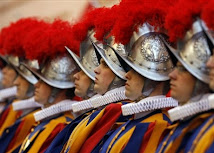
In other news, word was released by the Diocese of Phoenix that Bishop Thomas Olmstead, ordinary of that diocese, intends to reduce the frequency of distribution of the Eucharist under both species (that is, under the appearance of bread and under the appearance of wine.) The Press release makes clear that this is not, as many will portray it, a restricting of access to the Eucharist. Nor is it, as certain voices in the media may claim, a "turning back the clock on Vatican II." It is, in fact, a return to precisely what Vatican II called for in regard to the distribution of the Eucharist to the faithful.
The last forty or fifty years of liturgical development have been anything but an organic growth or reform of the liturgy. Surprising as it is for Catholics to hear, Vatican II was not the tremendous revolutionary moment it is portrayed to be, least of all in regard to the liturgy. Few of those in the revolutionary camp of liturgical "reform" have any familiarity with Sacrosanctum Concillium, much less a thorough knowledge of it. Particularly for young people, the status quo is assumed to be exactly what was called for by the Council. They assume the reason we have the priest standing behind a wooden table placed several feet in front of the altar, an army extraordinary ministers of Holy Communion gathered around him during the Eucharistic prayer, abstract art in place of images of the saints, pews arranged in a campfire circle, hand-holding during the Lord’s Prayer, and guitars strumming along to “Lord of the Dance” must be because this is what the Holy Spirit wanted the bishops to establish as the norm.
Hearing that “Latin is to be retained as the language or the Liturgy”, that “the people should be taught the parts of the mass in Latin that pertain to them”, that Gregorian chant is to be given “pride of place” among liturgical music, that the Council documents are entirely silent on the issue of versus populum celebration of the mass are all shocking to this generation of young adult Catholics.
Sadly, this too is the case with issue of distributing communion under both species. While specific conditions were laid out for the distribution of the chalice to the laity, those have long since been disregarded and universal distribution of the chalice at nearly every mass has become the norm. To enable this new norm requires using lay ministers to help distribute the Eucharist in a capacity that is far from “extraordinary”. Now, when a priest or bishop decides to employ the criteria established by Vatican II many faithful are up in arms, crying “clericalism” or “this grieves the Holy Spirit.”
It is quite a claim to say something grieves the Holy Spirit. The fact is that it was the Holy Spirit that was operative in the bishops at the Council, and the Holy Spirit that is operative in those bishops today in communion with the Pope. The Holy Spirit cannot grieve at the actions of the faithful bishops of the Church. Rather, the Holy Spirit grieves at the deliberate misinterpretation and misapplication of the liturgical principles laid out by the magisterium. The only spirit grieving over this decision is that old specter, the "Spirit of Vatican II."
 |
| The "Spirit of Vatican II" |
What about the “Fully conscious and active participation of the laity” that Vatican II called for? Fully Conscious and Active participation does not mean an army of lay “ministers” milling about the altar nor the untold instances of spilling the blood of our Lord. His blood was spilled once for our salvation and that was sufficient. Anything beyond that is disgraceful.
If the laity are fully conscious of what is going on in the liturgy and why it is happening, then there would be no misunderstanding. But alas, we have lots of “active” and very little “conscious” in liturgical participation these days.

The question becomes an issue of redundancy when one considers the Church's Eucharistic theology holds that Christ is fully present, Body, Blood, Soul & Divinity, under either form. When one receives the "bread" alone, one is still fully receiving the Lord. There is no "partial" Eucharist.
Some opponents of this decision appeal to historical precedent or to the easternlung of the Church where reception under both species is customary. In either instance the argument is founded on an apples-to-oranges comparison. If apostolic or eastern custom is sufficient cause to amend the discipline of the Latin Rite, then I ask, are those making this appeal willing to accept the other customs that surround the apostolic or eastern practice? Will they readily accept an ad orientem celebration of the Eucharist? The “obstruction” of their view of the altar by an iconostasis? The total absence of lay ministers, extraordinary or otherwise, in the distribution of the Eucharist? Receiving the Eucharist directly into an opened mouth rather than in the hand? These are all of a piece, not a liturgical buffet from which we can choose a la carte style.

The liturgical arguments can and will go on, but what is really at issue here is obedience to one’s bishop, and on that matter I will make my own appeal to Tradition, which unanimously exhorts the faithful to “do nothing without the bishop” (St. Ignatius of Antioch) and to “revere the bishop as the Lord himself.” (St. Cyprian of Carthage). Our obedience should not be mere assent of the lips, but of the will as well. For it is not enough to say, “yes, Father,” with his lips if he does not then go into the field and work. (cf. Matt. 21: 28 – 31). Is obedience a challenge? Most certainly, and yet it is the easy yoke of humble obedience that we must shoulder on the path to salvation.





No comments:
Post a Comment